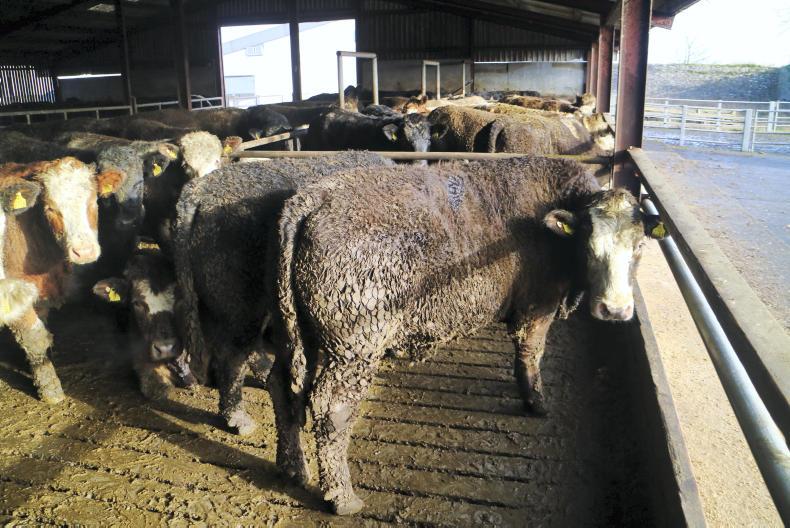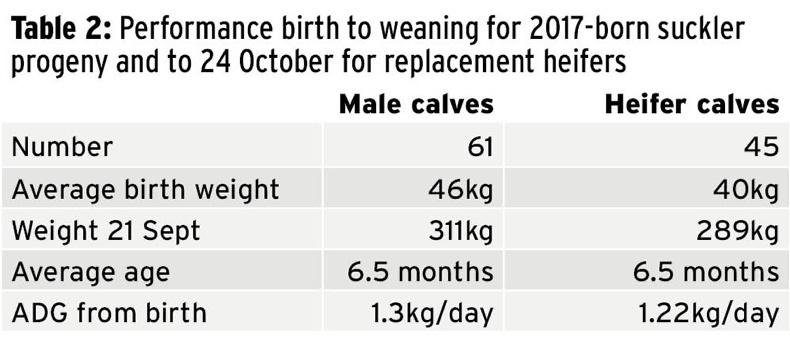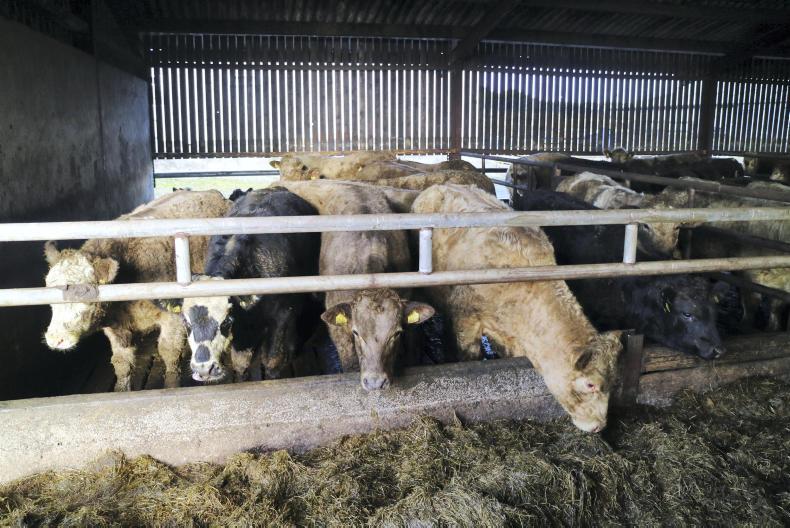The challenges faced by Newford Farm in Athenry, Co Galway are reflective of the weather-related pressure facing farmers along the western and northern regions of the country for the last few months.
The cause of the challenges, including earlier housing of cows and finishing stock and the resultant pressure on the farm’s fodder budget, have occurred from persistent heavy rainfall.
The farm has received just shy of 2ft of rainfall in the period from June to the first week of November. On a monthly basis, 119.5mm fell in June, 129.5mm in July, 103.1mm in August, 118.3mm in September and 123.3mm in October.
While similar volumes have fallen in these individual months in previous years, the fact that there has been no let-up in the heavy rainfall meant that grazing got progressively harder to deal with, cumulating in cows being housed faster for weaning in early September but never receiving the chance to be turned back outdoors.
Farm manager Matthew Murphy said: “We were in a good position up to the middle-to-end of August despite the heavy rainfall.
"We had achieved eight to nine grazings per grazing paddock and were growing enough grass. The problem was utilising it, especially in paddocks that received a bit of damage in the previous grazing.
"We thought housing was going to be short-term, but heavy rain just kept coming and left us with no chance of getting back outdoors. It was even hard to keep weanlings content when they went back outdoors”.
Earlier housing
The first 27 cows, including cull cows, were housed as planned on 10 September as per the farm’s autumn rotation planner’s aim of reducing grass demand and prioritising the best grass available on the Newford grazing block for weanlings.
These cows were planned to remain housed for a few days before being released back outdoors to clean off paddocks after weanlings.
A severe deterioration in ground conditions at the time saw the first batch followed by 33 cows just two days later, with all cows housed by 20 September, a month earlier than in 2016.
The consequences of earlier housing have been cows and steers eating into the fodder budget to the tune of 120t of silage. As the budget was already finely balanced to carry cows through to the end of March and weanlings to mid-March, this has created a shortfall of over 100t of silage. Options are currently being considered, and include purchasing silage to feed to dry cows and feeding concentrates and restricted silage to stretch existing supplies.
Cows were body condition scored last week and penned accordingly. There are 12 cows falling below a condition score of 2.5 and these have been penned together for preferential treatment. The group includes two cows that reared twins and are carrying twins again and, while borderline on falling below target condition, it is felt that giving these animals preferential treatment in mid-pregnancy will pay dividends.
The same can be said for all of the group, with addressing body condition now likely to positively influence breeding performance of these animals next spring. These cows will receive ad-lib 68 DMD silage and 2kg soya hulls until they have regained sufficient condition. The rest of the cows will receive second-cut silage, which was analysed at 62 DMD, with quality affected by weather delaying cutting.
Finishing steers
The finishing programme for steers was also affected by poor weather. As reported previously, a group of 27 of the lightest steers were housed on 13 September with the nine lightest heifers housed at a similar time to prioritise grass supplies for 33 heifers and 20 steers that could potentially be finished off grass. The 33 heifers were finished off grass, which was a good feat considering the weather, but the 20 steers remaining outdoors and receiving concentrate supplementation at 5kg per head daily (since 9 August) were doing too much damage to swards and had to be housed on 13 October.
The performance of these steers fell significantly in the seven-week period from 5 September to 25 October to 0.82kg daily, with steers averaging 652kg liveweight at 19.5 months of age and achieving a lifetime average daily gain of 1.03kg per day. “When ground conditions deteriorated badly, I moved troughs on to the farm roadway to reduce damage to swards.

"When steers were finished eating they were happy to stay on the roadway for a dry lie as opposed to going back into a wet field.
They probably performed pretty well when you take the conditions that were facing them into account,” said Matthew.
The batch of 27 steers that were housed on 8 September commenced concentrate supplementation on 14 September and were built up to 6kg per head daily. These animals achieved a higher daily gain of 0.97kg during the period 5 September to 25 October, which is not surprising given the low dry matter in grass and challenging conditions for the 20 steers remaining outdoors.
At an average weight of 569kg on 25 October and similar age of 19.5 months, their lifetime performance is significantly lower at 0.90kg daily.
Considering the growing silage deficit, a decision has been taken to transfer the 46 steers (one slaughtered last week) on to an ad-lib finishing diet. This will hopefully serve two purposes – limit the use of silage and increase daily liveweight and slaughter performance.
The aim is to draft the 19 heavier steers at the end of November/start of December or before then if deemed fit for slaughter, with the lighter steers targeted for slaughter from mid-December to the start of January.
Slaughter performance
Table 1 details the slaughter performance of cattle drafted in recent months. Heifers achieved an average carcase weight of 291kg, 52% kill-out and an average conformation and fat score of R=4-, grossing €1,163.73. One Simmental steer was slaughtered last week but was limited in his final sale value by a poor conformation score and lower than anticipated kill-out.

Weanling performance
The performance of weanling bulls and heifers has been a bright aspect of recent months. All animals were turned back outdoors once weaned with the batch of 20 weanlings from first-calving cows remaining outdoors and receiving 2kg concentrate supplementation daily.
The first batch of 52 weanlings were housed on 26 October with the remaining 35 achieving a two week longer grazing period and housed on 8 November.
Michael Fagan of Teagasc says that while weanlings may not look as good as they did a few weeks ago, they have retained their positive performance.
The male weanlings housed to date are weighing 350kg while the female weanlings are averaging 322kg, with both groups averaging 1.18kg daily since birth. The backs of all weanlings have been clipped, with mild weather and higher than normal temperatures making it harder initially for animals to settle indoors. Weanlings are receiving 68DMD silage and 2kg concentrate supplementation daily.
Replacement heifers
The 2017-born replacement heifers that are being contract-reared by Billy Gilmore are well on target. Sired by the AI Hereford sire DPS and an Angus stock bull, the heifers averaged 258kg and are well on target to hit their breeding weight of 340kg next May.







 This is a subscriber-only article
This is a subscriber-only article








SHARING OPTIONS: